Better-Fitted Probability of Hydraulic Conductivity for a Silty Clay Site and Its Effects on Solute Transport
Abstract
:1. Introduction
2. Materials and Methods
2.1. Sampling and Lithology
2.2. Method of Statistics
2.3. Random Modeling of Solute Transport to K Distribution
3. Results and Discussion
3.1. Hydraulic Conductivity of the Silty Clay Medium
3.2. Probability Density Function of the Low Hydraulic Conductivity Field
3.3. The Effects of K PDFs on Solute Transport
3.3.1. Effects of K PDFs on Peak Time
3.3.2. Effects of K PDFs on Peak Concentration
4. Conclusions
Acknowledgments
Author Contributions
Conflicts of Interest
References
- Freeze, R.A.; Cherry, J.A. Groundwater; Prentice Hall: Englewood Cliffs, NJ, USA, 1979. [Google Scholar]
- Kohlbecker, M.V.; Wheatcraft, S.W.; Meerschaert, M.M. Heavy-tailed log hydraulic conductivity distributions imply heavy-tailed log velocity distributions. Water Resour. Res. 2006, 42, W04411. [Google Scholar] [CrossRef]
- Wang, K.; Huang, G. Effect of permeability variations on solute transport in highly heterogeneous porous media. Adv. Water Resour. 2011, 34, 671–683. [Google Scholar] [CrossRef]
- Schertzer, D.; Lovejoy, S. Physical modeling and analysis of rain and clouds by anisotropic scaling multiplicative processes. J. Geophys. Res. 1987, 92, 9693–9714. [Google Scholar] [CrossRef]
- Freeze, R.A. A stochastic-conceptual analysis of one-dimensional groundwater flow in nonuniform homogeneous media. Water Resour. Res. 1975, 11, 725–741. [Google Scholar] [CrossRef]
- Bjerg, P.L.; Hinsby, K.; Christensen, T.H.; Gravesen, P. Spatial variability of hydraulic conductivity of an unconfined sandy aquifer determined by a mini slug test. J. Hydrol. 1992, 136, 107–122. [Google Scholar] [CrossRef]
- Hess, K.M.; Wolf, S.H.; Celia, M.A. Large-scale natural gradient tracer test in sand and gravel, cape cod, massachusetts: 3. Hydraulic conductivity variability and calculated macrodispersivities. Water Resour. Res. 1992, 28, 2011–2027. [Google Scholar] [CrossRef]
- Turcke, M.A.; Kueper, B.H. Geostatistical analysis of the borden aquifer hydraulic conductivity field. J. Hydrol. 1996, 178, 223–240. [Google Scholar] [CrossRef]
- Sudicky, E.A. A natural gradient experiment on solute transport in a sand aquifer: Spatial variability of hydraulic conductivity and its role in the dispersion process. Water Resour. Res. 1986, 22, 2069–2082. [Google Scholar] [CrossRef]
- Woodbury, A.D.; Sudicky, E.A. The geostatistical characteristics of the borden aquifer. Water Resour. Res. 1991, 27, 533–546. [Google Scholar] [CrossRef]
- Cheng, C.; Song, J.; Chen, X.; Wang, D. Statistical distribution of streambed vertical hydraulic conductivity along the platte river, nebraska. Water Resour. Manag. 2011, 25, 265–285. [Google Scholar] [CrossRef]
- Sánchez-Vila, X.; Carrera, J.; Girardi, J.P. Scale effects in transmissivity. J. Hydrol. 1996, 183, 1–22. [Google Scholar] [CrossRef]
- Hyun, Y. Multiscale Anaylses of Permeability in Porous and Fractured Media. Ph.D. Thesis, The University of Arizona, Tucson, AZ, USA, 2002. [Google Scholar]
- Rehfeldt, K.R.; Boggs, J.M.; Gelhar, L.W. Field study of dispersion in a heterogeneous aquifer: 3. Geostatistical analysis of hydraulic conductivity. Water Resour. Res. 1992, 28, 3309–3324. [Google Scholar] [CrossRef]
- Vereecken, H.; Döring, U.; Hardelauf, H.; Jaekel, U.; Hashagen, U.; Neuendorf, O.; Schwarze, H.; Seidemann, R. Analysis of solute transport in a heterogeneous aquifer: The krauthausen field experiment. J. Contam. Hydrol. 2000, 45, 329–358. [Google Scholar] [CrossRef]
- Bagarello, V.; Iovino, M.; Elrick, D. A simplified falling-head technique for rapid determination of field-saturated hydraulic conductivity. Soil Sci. Soc. Am. J. 2004, 68, 66–73. [Google Scholar] [CrossRef]
- Dagan, G. Flow and Transport in Porous Formations; Springer: Berlin/Heidelberg, Germany, 1989. [Google Scholar]
- Liang, J.; Zeng, G.; Guo, S.; Li, J.; Wei, A.; Shi, L.; Li, X. Uncertainty analysis of stochastic solute transport in a heterogeneous aquifer. Environ. Eng. Sci. 2009, 26, 359–368. [Google Scholar] [CrossRef]
- Ye, B.; Zhang, Z.; Mao, T. Petroleum hydrocarbon in surficial sediment from rivers and canals in Tianjin, China. Chemosphere 2007, 68, 140–149. [Google Scholar] [CrossRef] [PubMed]
- Cong, S. Probability and Statistical Methods in Water Science and Technology; Science Press: Beijing, China, 2010. [Google Scholar]
- Painter, S. Flexible scaling model for use in random field simulation of hydraulic conductivity. Water Resour. Res. 2001, 37, 1155–1163. [Google Scholar] [CrossRef]
- Yang, C.-Y.; Hsu, K.-C.; Chen, K.-C. The use of the levy-stable distribution for geophysical data analysis. Hydrogeol. J. 2009, 17, 1265–1273. [Google Scholar] [CrossRef]
- Liang, Y.; Chen, W. A survey on computing lévy stable distributions and a new matlab toolbox. Signal Process. 2013, 93, 242–251. [Google Scholar] [CrossRef]
- Nolan, J.P. Parameterizations and modes of stable distributions. Stat. Probab. Lett. 1998, 38, 187–195. [Google Scholar] [CrossRef]
- Helsel, D.R.; Hirsch, R.M. Statistical Methods in Water Resources Techniques of Water Resources Investigations; U.S. Geological Survey: Reston, VA, USA, 2002; Volume 4, p. 522. [Google Scholar]
- Arnold, T.B.; Emerson, J.W. Nonparametric goodness-of-fit tests for discrete null distributions. R J. 2011, 3, 34–39. [Google Scholar]
- Stephens, M.A. Edf statistics for goodness of fit and some comparisons. J. Am. Stat. Assoc. 1974, 69, 730–737. [Google Scholar] [CrossRef]
- De Jong, G.D.J. Longitudinal and transverse diffusion in granular deposits. In Soil Mechanics and Transport in Porous Media: Selected works of g. De Josselin de Jong; Schotting, R.J., van Duijn, H.C.J., Verruijt, A., Eds.; Springer: Dordrecht, The Netherlands, 2006; pp. 261–268. [Google Scholar]
- Gégo, E.L.; Johnson, G.S.; Hankins, M. An evaluation of methodologies for the generation of stochastic hydraulic conductivity fields in highly heterogeneous aquifers. Stoch. Environ. Res. Risk Assess. 2001, 15, 47–64. [Google Scholar] [CrossRef]
- Teatini, P.; Ferronato, M.; Gambolati, G.; Baù, D.; Putti, M. Anthropogenic venice uplift by seawater pumping into a heterogeneous aquifer system. Water Resour. Res. 2010, 46, W11547. [Google Scholar] [CrossRef]
- Painter, S. Stochastic interpolation of aquifer properties using fractional lévy motion. Water Resour. Res. 1996, 32, 1323–1332. [Google Scholar] [CrossRef]
- Tennekoon, L.; Boufadel, M.C.; Lavallee, D.; Weaver, J. Multifractal anisotropic scaling of the hydraulic conductivity. Water Resour. Res. 2003, 39, SBH 8-1. [Google Scholar] [CrossRef]
- Boufadel, M.C.; Lu, S.L.; Molz, F.J.; Lavallee, D. Multifractal scaling of the intrinsic permeability. Water Resour. Res. 2000, 36, 3211–3222. [Google Scholar] [CrossRef]
- Liu, H.H.; Molz, F.J. Multifractal analyses of hydraulic conductivity distributions. Water Resour. Res. 1997, 33, 2483–2488. [Google Scholar] [CrossRef]
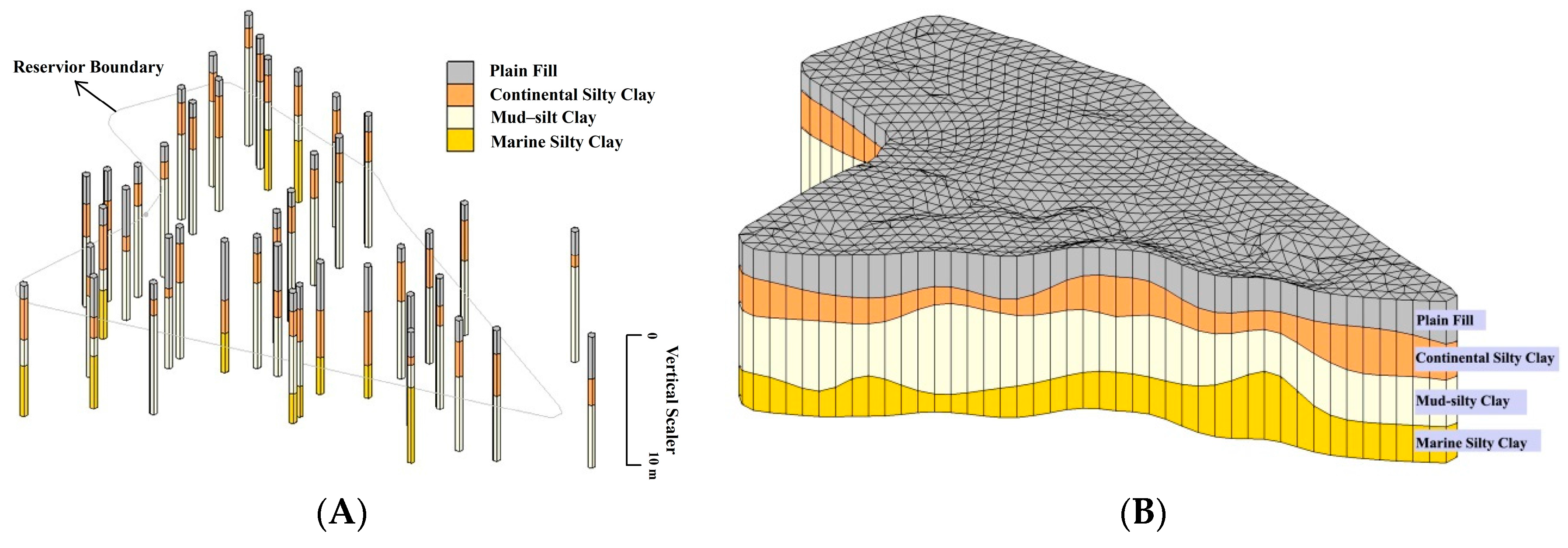

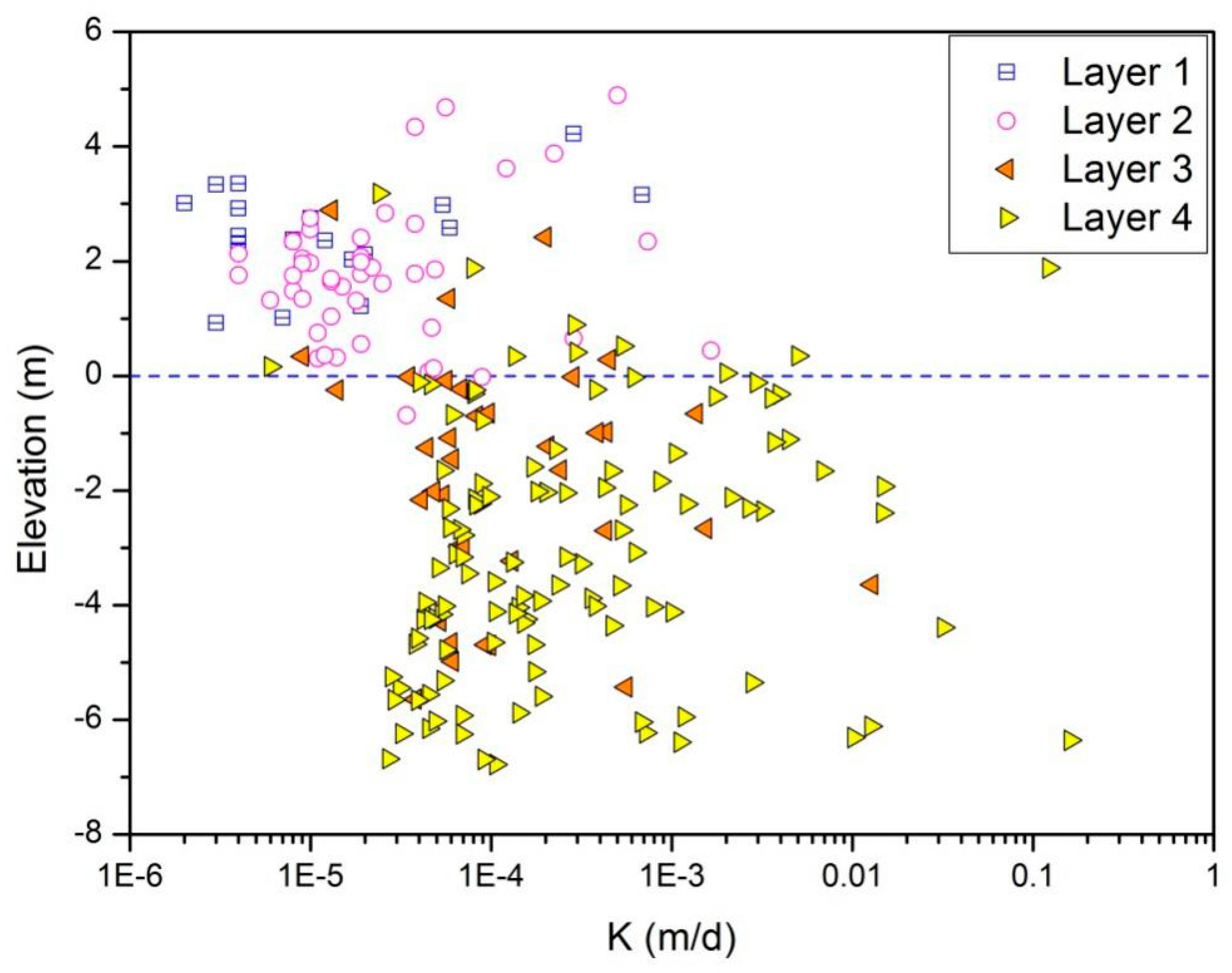

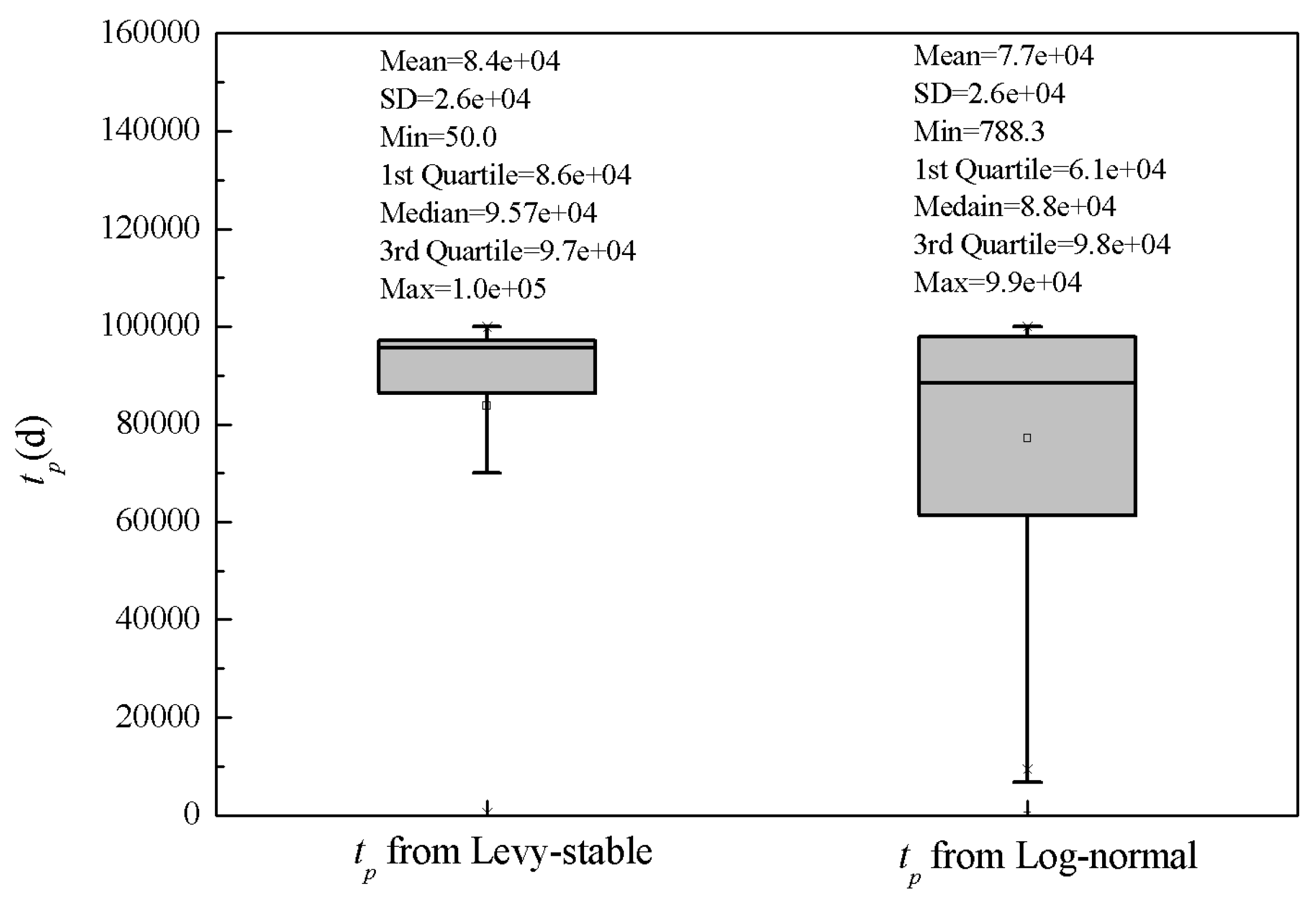
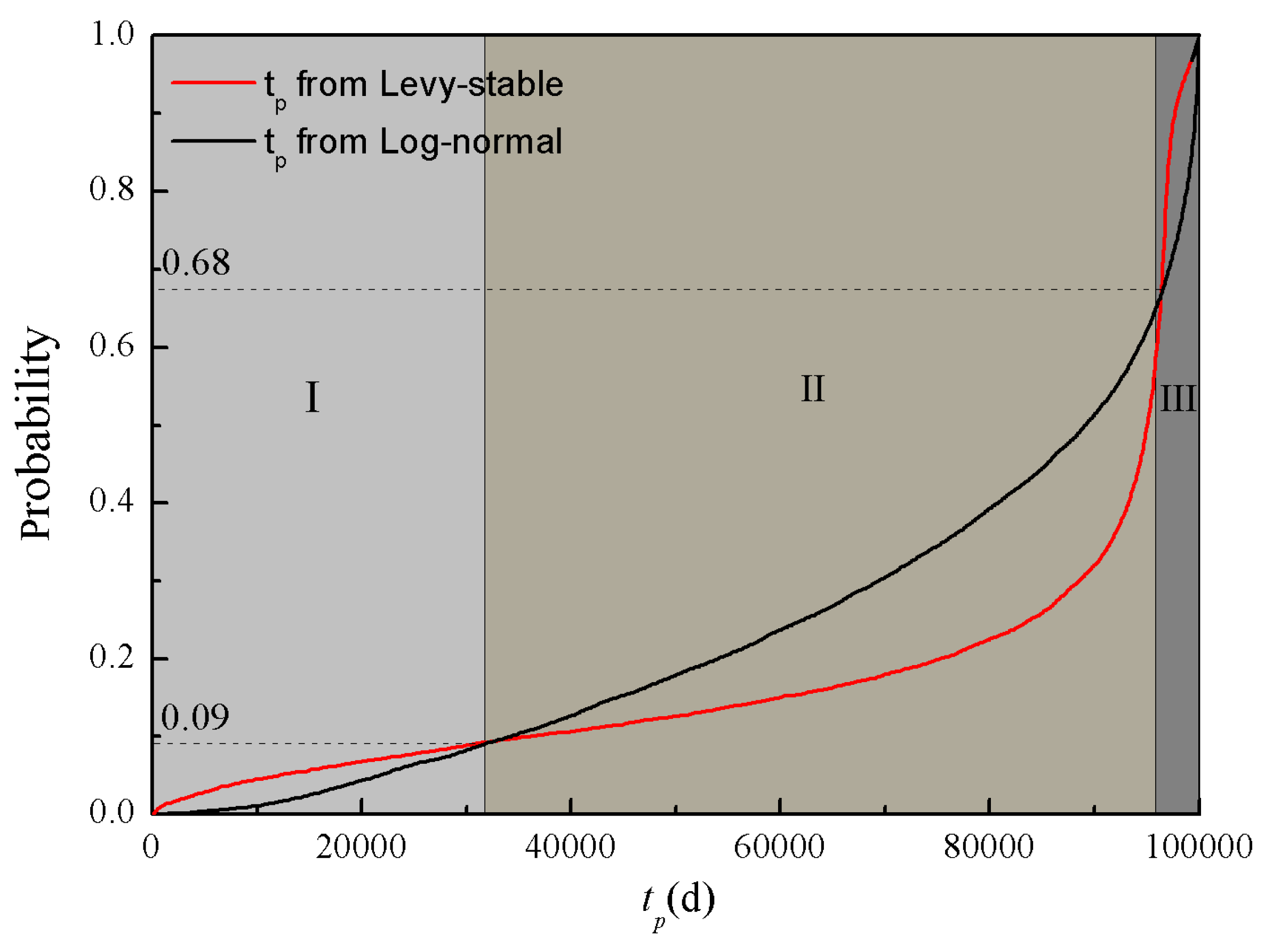
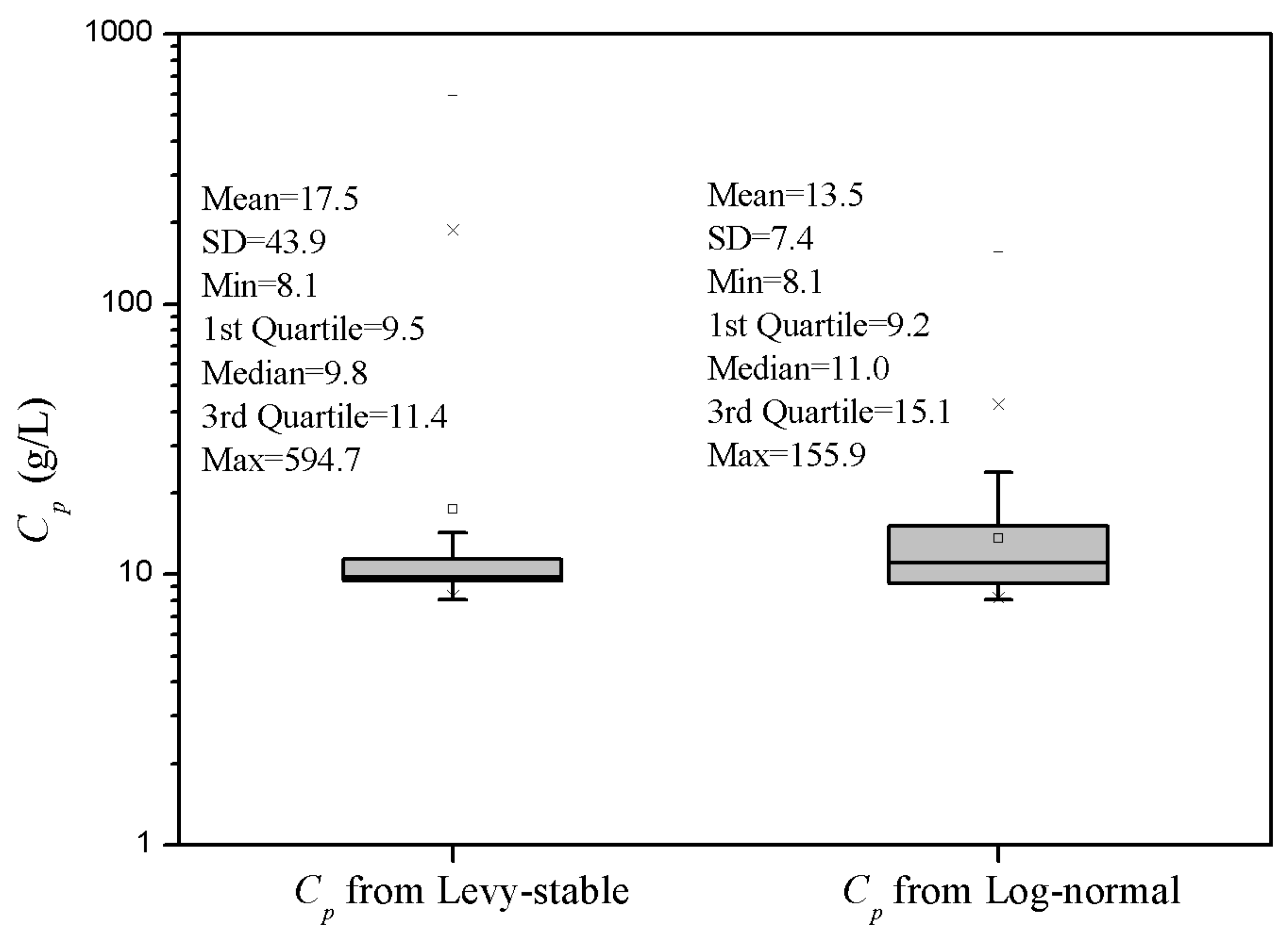
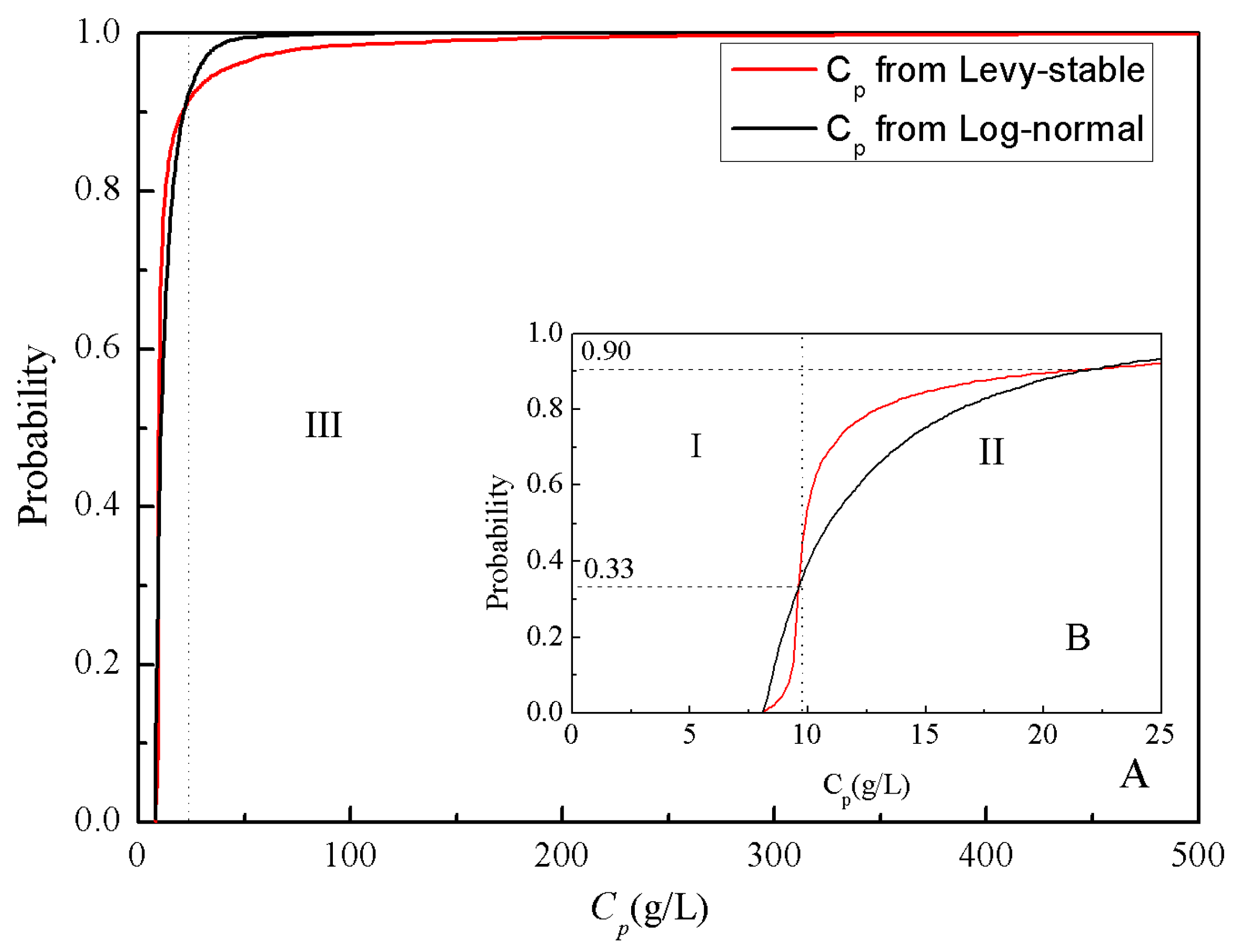
| Geologic Material | First Layer | Second Layer | Third Layer | Fourth Layer | |
|---|---|---|---|---|---|
| K (m/d) | Min | 2 × 10−6 | 4 × 10−6 | 9 × 10−6 | 6 × 10−6 |
| Max | 6.8 × 10−4 | 1.6 × 10−3 | 1.3 × 10−2 | 1.6 × 10−1 | |
| Mean | 6.7 × 10−5 | 9.5 × 10−5 | 5.6 × 10−4 | 3.9 × 10−3 | |
| SD | 1.68 × 10−4 | 2.79 × 10−4 | 2.12 × 10−3 | 1.92 × 10−2 | |
| Sample size | 18 | 46 | 36 | 112 | |
| Lithology | Plain fill | Continental silty clay | Mud–silt clay | Marine silty clay | |
| Type of PDF | Second Layer | Third Layer | Fourth Layer | |
|---|---|---|---|---|
| Normal | K–S | No | No | No |
| A–D | No | No | No | |
| Fitted Parameters | = 9.55 × 10−5 | = 5.63 × 10−4 | = 0.0039 | |
| = 2.70 × 10−4c | = 2.1 × 10−3 | = 0.0192 | ||
| Log-normal | K–S | Yes | Yes | No |
| A–D | Yes | Yes | No | |
| Fitted Parameters | = −10.59 | = −9.08 | = −8.25 | |
| = 1.33 | = 1.44 | = 1.91 | ||
| Levy | K–S | Yes | Yes | Yes |
| A–D | Yes | Yes | Yes | |
| Fitted Parameters | = 0.46 | = 0.52 | = 0.52 | |
| = 1 | = 0.39 | = 1 | ||
| = 4.48 × 10−6 | = 2.10 × 10−5 | = 5.93 × 10−5 | ||
| = 7.47 × 10−6 | = 5.30 × 10−5 | = 2.10 × 10−6 | ||
| Gamma | K–S | No | No | No |
| A–D | No | No | No | |
| Fitted Parameters | a = 0.48 | a = 0.41 | a = 0.26 | |
| b = 0.0002 | b = 0.0014 | b = 0.015 | ||
| Weibull | K–S | No | Yes | No |
| A–D | No | No | No | |
| Fitted Parameters | a = 0.0001 | a = 0.0002 | a = 0.0007 | |
| b = 0.6 | b = 0.56 | b = 0.43 | ||
© 2017 by the authors. Licensee MDPI, Basel, Switzerland. This article is an open access article distributed under the terms and conditions of the Creative Commons Attribution (CC BY) license (http://creativecommons.org/licenses/by/4.0/).
Share and Cite
Lu, C.; Qin, W.; Zhao, G.; Zhang, Y.; Wang, W. Better-Fitted Probability of Hydraulic Conductivity for a Silty Clay Site and Its Effects on Solute Transport. Water 2017, 9, 466. https://doi.org/10.3390/w9070466
Lu C, Qin W, Zhao G, Zhang Y, Wang W. Better-Fitted Probability of Hydraulic Conductivity for a Silty Clay Site and Its Effects on Solute Transport. Water. 2017; 9(7):466. https://doi.org/10.3390/w9070466
Chicago/Turabian StyleLu, Chengpeng, Wei Qin, Gang Zhao, Ying Zhang, and Wenpeng Wang. 2017. "Better-Fitted Probability of Hydraulic Conductivity for a Silty Clay Site and Its Effects on Solute Transport" Water 9, no. 7: 466. https://doi.org/10.3390/w9070466
APA StyleLu, C., Qin, W., Zhao, G., Zhang, Y., & Wang, W. (2017). Better-Fitted Probability of Hydraulic Conductivity for a Silty Clay Site and Its Effects on Solute Transport. Water, 9(7), 466. https://doi.org/10.3390/w9070466





